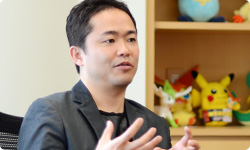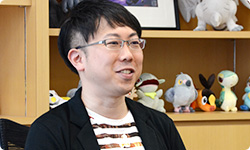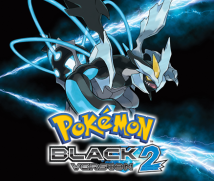5. What Pokémon Values
As we discussed earlier, Pokémon has become a communication medium that transcends language around the world. When you make a Pokémon game, what do you pay special attention to?
I pay attention to how readily someone who has never played the series can play it.

For a lot of children, the first game they get is a Pokémon game.
Yes, so I try to put in lots of elements that are easy to understand. For battles, I pursue depth, so I create a building like a tower and have players who want to battle enjoy that, but I don’t mind if others who aren’t interested just pass by.
You can try to collect cute Pokémon or all types of Pokémon or complete the story or strengthen your favourite Pokémon or be top of the world in battles. Not everyone has to play toward the same goals. It may be a characteristic of Pokémon games to be open to all types, have depth and allow players lots of freedom with regard to central goals.
I think it is.
Something that I have always thought was amazing about Pokémon is how everyone’s favourite Pokémon are so different. Usually when there are lots of characters, opinion tends to solidify around certain ones, but when I ask players about Pokémon, there are some surprising favourites.
Yes. We pay a lot of attention to the variety of Pokémon. For example, when we’ve thought, “Is this all right?” in character design, a different appeal will come out depending on the moves we give them, their settings and where they appear.
Oh, I see. The character design doesn’t complete the Pokémon, but rather the moves, settings and game world also generate their characteristics, so they each have their own distinctive appeal, giving rise to popularity for each one.
Yes, I believe so. In Pokémon Red Version and Pokémon Green Version18, Pikachu hardly ever appeared in Viridian Forest. I’m not so sure if Pikachu would have been as popular if they had shown up more frequently. 18: Videogames released for the Nintendo Game Boy system in February 1996 in Japan. They were the first games in the Pokémon series. was later renamed in the west.
If Pikachu was an easy Pokémon to get, people wouldn't have so much affection for it.
Right. At one point, Tauros was super popular at tournaments like the Pokémon World Championships because of its strength. I thought popularity because of strength was amazing.
People do admire and respect strong things. But GAME FREAK has a staggering array of ways to make the Pokémon it comes up with distinctive and as a result of many people making the game together, the Pokémon have the strength to endure.
Ideas are necessary for thinking up new Pokémon, so rather than doing it alone, it’s better to do it in large numbers. Surprisingly, the young staff members come up with the wildest ideas. (laughs)
They bring a breath of fresh air.
Yes. Otherwise, Pokémon that are flat like a flounder, the way Stunfisk is, wouldn’t come up! (laughs)
Unno-san, what do you think about what the Pokémon games value in appearance?
Let’s see… Having worked on the games all this time, I think – as Masuda-san mentioned – what’s important is variety, but also simple approachability. Examples would be becoming interested because it’s cute, simplicity like rock-paper-scissors in battle, or preserving the classic storyline of a normal youth growing up while off on a journey. I think something the Pokémon games value is how a lot of meaning is packed in, even though they look simple at first glance.

When simple games stick around for a long time, they are actually deep.
Yeah. Masuda-san always says that rock-paper-scissors is a deep game.
Yes. (laughs) I always analyse it, like, it isn’t really a good match if you don’t start by counting off at the beginning.
A number of elements are necessary to pull it off right.
Right. For example, we talked about how it would be to play it blindfolded. When it comes to Pokémon design, the way they look as living creatures is significant, like why one has red cheeks or why one’s tail is a certain shape.
A characteristic of Pokémon is that when you make character-related products, you always ask what makes it this particular Pokémon.
Yes. They look simple, but have meaning. Players naturally accept that and share it unconsciously. When I first became involved with Pokémon, Masuda-san got angry at me for how I placed the flowers in town. I had them placed in a flashy, pretty way, and Masuda-san said, “Unno-san, if you put flowers in the town here, does that mean you would walk on them?”
(laughs)
Then I noticed that instead of just casually placing flowers in front of the houses, you have to pay attention to the fact that people live there, why flowers are there and whether they’re small flowers or big flowers. I think it is important to present what we see and feel in our daily lives without having it stand out.
